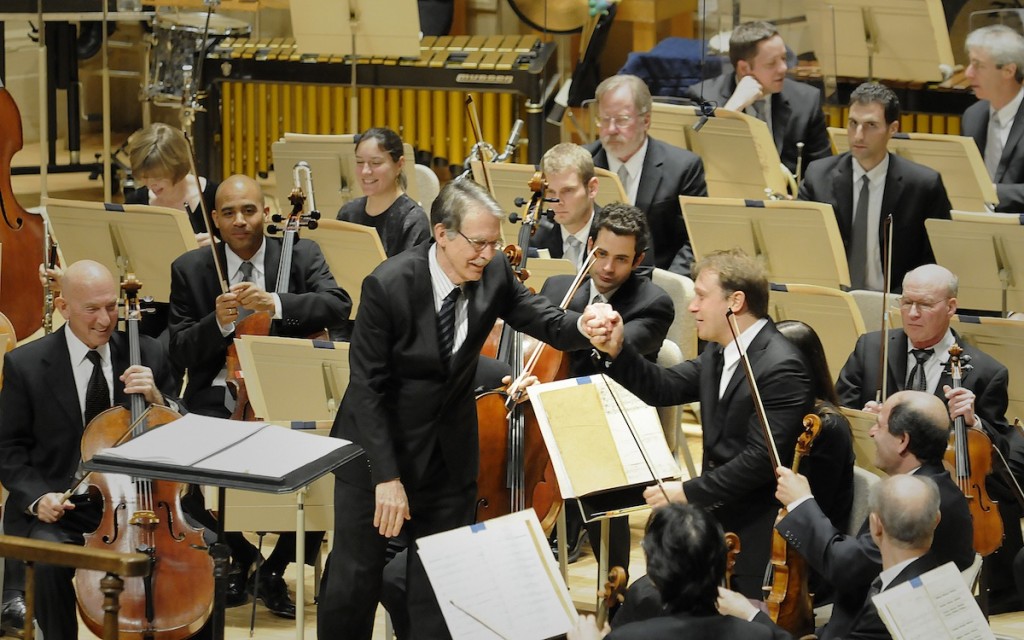Morlot takes up the BSO’s Harbison mantle in convincing fashion

John Harbison shakes hands with conductor Ludovic Morlot following the Boston Symphony Orchestra performance of Harbison's Symphony No. 4 Friday afternoon. Photo: Stu Rosner
The Boston Symphony Orchestra continued its two-year survey of John Harbison’s symphonies, with Ludovic Morlot conducting the composer’s fourth essay in the genre Friday afternoon at Symphony Hall.
Harbison has a long BSO affiliation. His Symphony No. 1 (1984) was a BSO commission, as was the Fifth, to be performed next week, and the Sixth, which will premiere at Symphony Hall in January.
The Harbison cycle was conceived by departed maestro James Levine, and the first three symphonies were heard last season. Levine, who also commissioned Harbison’s opera, The Great Gatsby, for the Met, brought an unusual degree of understanding and insight to last year’s programs.
But Levine is now gone, and Friday afternoon Morlot served the Harbison Fourth Symphony extraordinarily well. The former BSO assistant, in the midst of several appearances at Symphony Hall before embarking on a west coast tour with the orchestra in December, has grown into a confident leader.
Written in 2003, immediately after the somewhat bittersweet reception of Gatsby, the Fourth Symphony journeys through five disparate movements. The music shifts ideas incessantly: the opening Fanfare carries the flavor of Gatsby, presenting a pastiche of jazzy ideas, set in formal structures. The second movement offers a bewildering array of themes, connected by a mood of introspection. The scherzo, the most straightforward of the sections, lacks humor but suggests an antic energy. The centerpiece, a fourth movement labeled Threnody, begins with a string-based theme, deeply lyrical and pensive, with accents from the back of the orchestra. The Finale creates some ease for the listener, shifting to less tense, major harmonies.
The challenge for a conductor is to link these contrasted movements into a cohesive and communicative whole. Morlot impressed with his command of the score and a sense that he knew what he wanted next from the musicians. The playing throughout was alert to Morlot’s direction, and sensitive to the shifting demands. Concertmaster Malcolm Lowe rendered several solo sections with aplomb, and multiple oboe excursions by Keisuke Wakao in the Intermezzo were exquisite.
The ambitious program also included the second suite from Ravel’s Daphnis and Chloé, and Mahler’s Symphony No. 1.
Daphnis and Chloé is a BSO staple, both in its complete orchestral form, recorded by the orchestra with Levine, and in this most familiar excerpt. Principal flute Elizabeth Rowe attacked the breathtaking solo section in the middle of the suite, choosing not to portray the mood as rapturous, but instead as aggressive, almost sexual. Morlot’s direction chose the same tack, accenting sharper than usual dynamics (at least compared to Levine’s recording). The result proved an exciting take on a familiar work.
Morlot maintained his intensity while conducting Mahler’s First Symphony. Morlot has an athleticism that suits the music, and impressed with an awareness of the flow of this score as well. Dynamics were sometimes exaggerated, but within artistic reason. There were many orchestral highlights: a gorgeous melodic turn by principal bass Edwin Barker; s lyrical interludes from Lowe, principal cellist Jules Eskin and principal viola Steven Ansell; and colorful shadings by harpist Jessica Zhou, especially in the first movement.
The program will be repeated 8 p.m. Saturday and Tuesday. bso.org; 617-266-1492.
Posted in Performances




